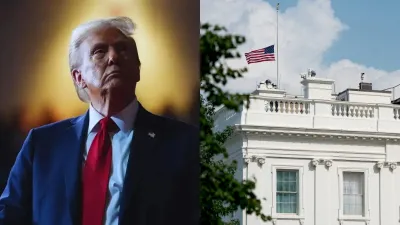
President-elect Donald Trump has voiced frustration that US flags will be flown at half-staff during his inauguration on January 20.
This decision, initiated by outgoing President Joe Biden, honors the late President Jimmy Carter, who passed away on Sunday at the age of 100. While the timeline for lowering flags is based on the US flag code and not immediately reversible, Trump has hinted at potential changes once he assumes office.
The practice of flying flags at half-staff signals national mourning and respect for significant losses or tragedies. In this case, President Biden ordered the flags lowered for 30 days following Carter’s death, a standard period designated for a current or former president.

This directive applies to all federal buildings, military installations, embassies, and other facilities domestically and abroad. State flags are also lowered, as no flag is allowed to fly higher than the US flag on the same pole.
Carter’s death triggered a 30-day mourning period, which means the flags will remain at half-staff until January 28. This includes Trump’s inauguration and the first week of his presidency. While the US flag code outlines this timeline, it is not legally binding.
Once inaugurated, Trump could theoretically alter or shorten the period, as past presidents have done under exceptional circumstances.

For example, in 1973, President Richard Nixon temporarily raised flags to honor the return of American prisoners of war from Vietnam, despite being in the middle of a mourning period for former President Lyndon Johnson. The flags were later returned to half-staff.
Trump expressed his discontent over this issue in a Truth Social post, calling it a politically motivated move. “Democrats are all ‘giddy’ about this notion,” he wrote. “Nobody wants to see this. No American can be happy about it. Let’s see how it plays out. MAKE AMERICA GREAT AGAIN!”
Despite his frustration, Trump currently has no authority to override the decision until he takes office. The White House, under Biden’s leadership, confirmed it would not reconsider or modify the plan, with Press Secretary Karine Jean-Pierre affirming the commitment to honoring Carter’s legacy.

Lowered flags during a presidential inauguration are rare but not unprecedented. In January 1973, when Nixon was sworn in for his second term, flags were already at half-staff due to Truman’s death.
Similarly, flags lowered for Johnson’s passing were briefly raised during Nixon’s presidency for another event but quickly returned to half-staff. This pattern highlights how the tradition aligns with solemn national moments, even when coinciding with celebratory events like inaugurations.
This isn’t the first time Trump has challenged flag-lowering protocols. In 2018, following the death of Senator John McCain, with whom Trump had a contentious relationship, the president initially ordered flags to be lowered but raised them to full staff within days.

This decision sparked bipartisan criticism, prompting him to lower the flags again. McCain’s family, however, declined to invite Trump to the senator’s funeral, a move that underscored their strained relationship.
Once in office, Trump will have the authority to modify or overturn the current flag-lowering timeline. The US flag code serves as a guideline rather than a strict mandate, allowing the president discretion in such matters.
However, any decision to raise the flags early could invite significant political and public scrutiny, especially given the solemnity of Carter’s passing.

As the nation prepares for Trump’s inauguration, the overlap of a national mourning period with the transfer of power underscores the complexities of balancing tradition, respect, and political optics.
Whether Trump will take action regarding the flags after assuming office remains to be seen, but the debate itself reflects the charged political environment as his presidency begins.



